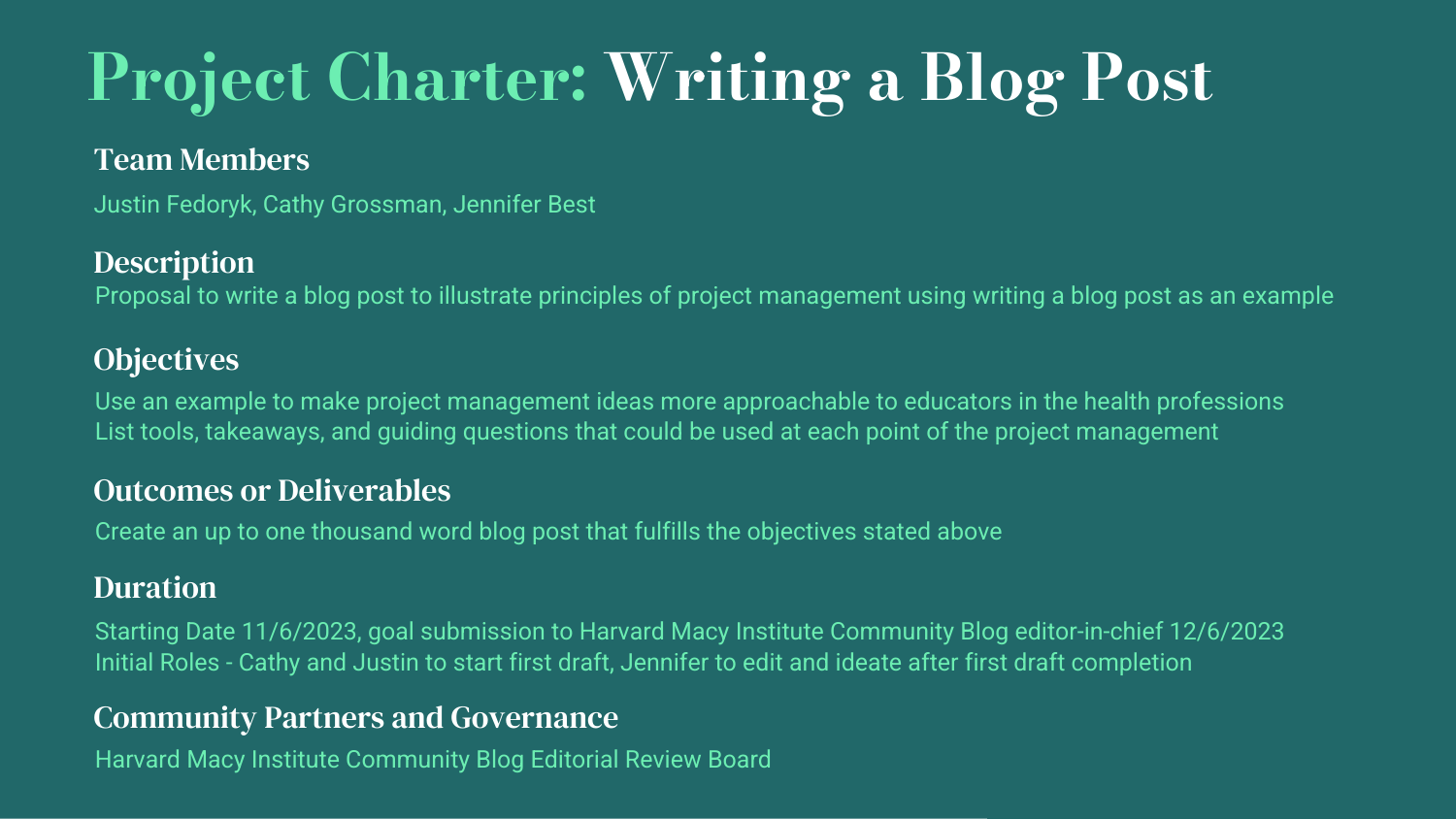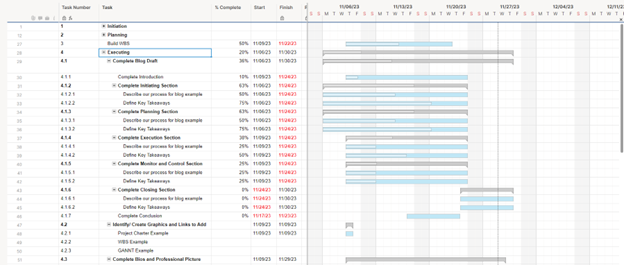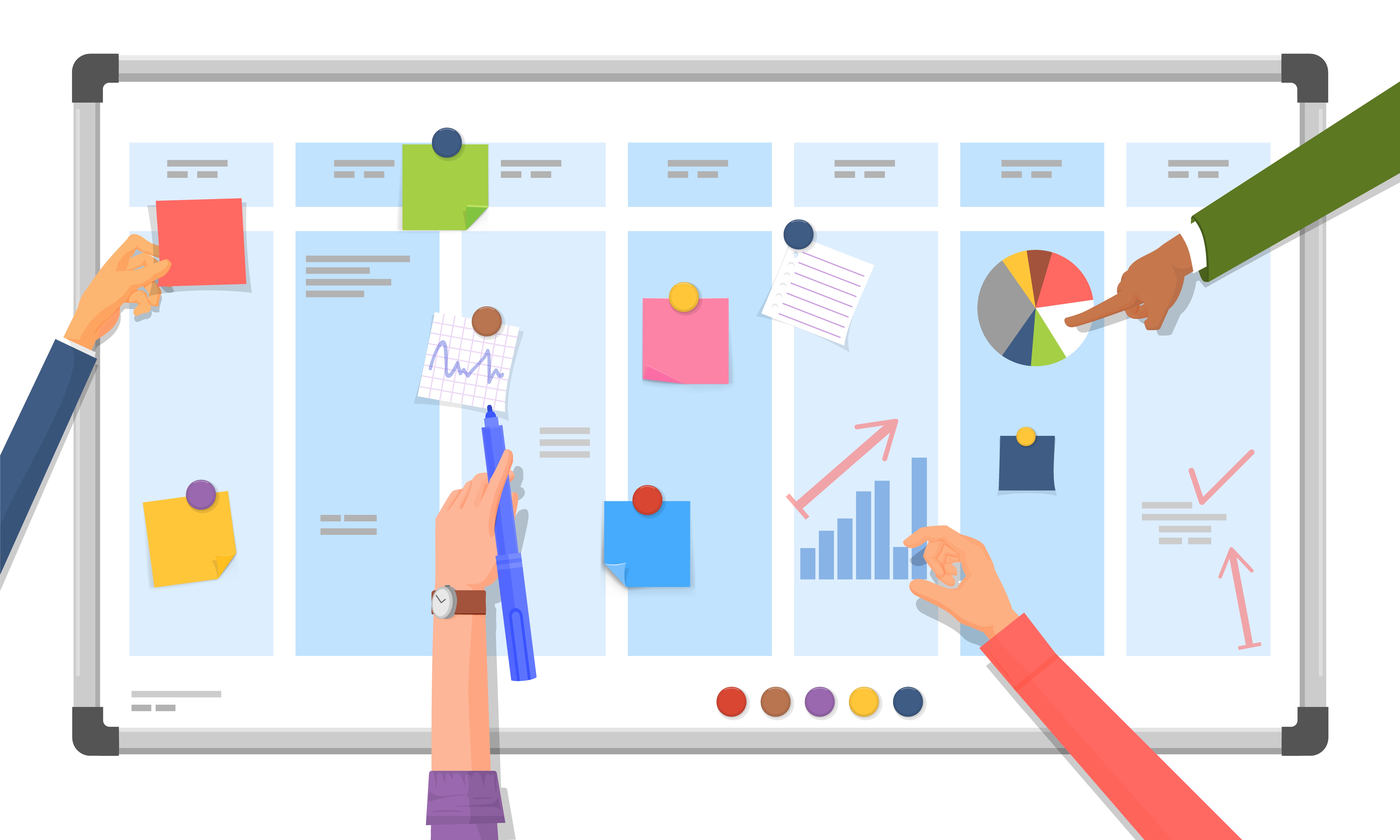When starting a new project, the idea of implementing project management (PM) tools, practices, and frameworks can feel daunting. We hope to mitigate this stigma of “extra work” by reframing PM strategies as explicit preparation at project inception that creates clarity of purpose, roles and responsibilities, operational processes, and the roadmap for completion. In this blog post, we will demonstrate PM principles within a project example of “writing a collaborative blog post,” highlighting key takeaways from each phase.
Initiating Phase:
We started with an informal project charter as shared in figure 1. We assessed project feasibility by discussing individual availability and interest and then aligned on an idea. After discussing our idea for the blog post with the HMI Community Blog editor-in-chief, we proceeded to outline our blog post.

Figure 1. Blog Project Charter
Initiating Phase Takeaways:
- Project Charter Creation: Hone this like an elevator pitch that concisely defines your project’s purpose, objectives, relevant partners, timeline, and resources.
- Scope Definition: Delineate clearly what is and is not included in the project and deliverables, then you are less likely to veer off course.
- Feasibility Assessment: Initiate candid discussions with your team about bandwidth and resources.
- Resource Allocation: Audit required resources, including your own time. Start securing approvals for resources or identifying alternative solutions if available.
Planning Phase:
We organized the work breakdown structure (WBS) for the blog post in a top-down manner, deconstructing the overall deliverables into smaller and smaller packages. We divided our overall content by PM phase - initiation, planning, execution, monitoring and controlling, and closing - then subdividing phases into key subcomponents. To ensure a smooth writing flow, content creation for each phase was dependent upon the completion of the previous phase's content. We planned to communicate progress through in-person and virtual meetings and to review changes on Google Docs to collaborate using a shared document repository. Without a need for a budget, we defaulted to available familiar workplace resources. For PM software solutions, Smartsheet was chosen for the creation of our project Gantt chart (figure 2), which included task deadline estimates and kanban board; a Post-it(™) note kanban board was a lower-tech backup.
Next, we explored risk mitigation. Given upcoming holiday and work commitments, we preemptively agreed to communicate delays via email and impromptu discussions. If necessary, we agreed to push back our timeline for goal submission. We predicted initial inefficiencies as a new team and potential communication and workflow barriers across varying time zones and institutions.

Figure 2. Sample Gantt chart
Planning Phase Takeaways:
- Resource Planning: Identify specific resources, including budget, software, tools, expertise required, and time.
- Project Schedule: Visualize graphically the sequence of required tasks in a logical order noting dependencies and duration estimates. Update this graphic visualization as tasks are completed and use it to track expected progress against actual progress.
- WBS: Create the WBS using a top-down approach. Assign team members and resources to subtasks. Note which tasks are dependent on others before they can be started or completed.
- Communication Plan: Establish guidelines for communication, including the medium, recipients, content, and response time. Consider weekly standing meetings for progress checks and as-needed meetings to address important emerging issues.
- Risk Planning: Identify and prioritize risks to project completion based on likelihood and impact, considering your team's risk tolerance. Develop risk mitigation plans, which could include seeking deadline extensions, additional resources, adapting in-person activities to virtual formats, or risk acceptance.
Executing Phase:
We utilized designated PM software solutions to visually track real-time progress. Team members worked through assigned tasks and deadlines from our WBS and project schedule. We respected boundaries defined by personal lives, favorite sports teams, time zones, and communication methods.
Executing Phase Takeaways:
- Communication Plan: Honor your agreements. Authentically engage with your project team members, sponsors, and partners, listen actively, value contributions, and be mindful of their lives outside of this project.
- WBS and Project Schedule: Share small wins such as completed tasks to bolster team motivation and morale.
Monitoring and Controlling Phase:
In weekly meetings, progress and roadblocks were discussed to ensure the project’s objectives are being met. During writing, we navigated format changes to the ‘takeaways section’ via asynchronous communication. For larger teams, a well-documented change process reviewed by designated team members is critical for alignment. After a project launches, requests are often made for “additions” or “modifications” known as scope creep. While some flexibility is reasonable, scope creep should be closely managed as even minor changes can snowball into project-halting problems if not mitigated and communicated to the project team effectively.
Monitoring and Controlling Phase Takeaways:
- Communication: Adhere to the communication plan and scheduled meetings, even if they are short updates.
- WBS and Project Schedule: Detect any deviations in expected progress using the project schedule visualization. Identify the need to deploy risk mitigation plans.
- Change Management: Follow establish change management protocol. Document any agreed upon changes made to a project.
Closing Phase
Applying PM tools enabled structured co-creation of this post by facilitating communal clarity surrounding required steps, schedules, and team member responsibilities. The initial framework aided drafting within the proposed timeline despite inevitable roadblocks, allowing time for the HMI Community Blog Editorial Review Board process. Upon final publication, we planned celebrations with virtual high fives and a trip for coffee. The project debrief was planned four to six weeks after completion to allow for reflection time.
Closing Phase Takeaways:
- Communication: Celebrate project completion and distribute project deliverables to team members and project sponsors.
- Debrief the Project: Document lessons learned for future reference. Consider whether to parlay this work into another project.
Applying PM practices lightens team workload by streamlining project processes and providing clear plans and expectations. This post highlights the adaptability of PM principles in diverse projects and underscores the significance of communication, planning, and continuous improvement in project management. Even with encountering detours on our project roadmap, the PM principles guided our route, navigating us to the destination successfully (albeit a week late.)
Did you know that the Harvard Macy Institute Community Blog has had more than 375 posts? Previous blog posts have explored topics including getting the grant, the evolution of a scholarly project, and feedback and group ownership in project design.

Justin Fedoryk, PMP, MS is the Senior Supervisor and Project Manager for the Center for Human Simulation and Patient Safety at Virginia Commonwealth University. Justin’s areas of professional interest include leadership development, project management, and educational technology. Justin can be reached via email.

Cathy Grossman, MD (Educators ’18) is a medical educator, Associate Professor of Pulmonary & Critical Care Medicine, and Director of the Center for Human Simulation and Patient Safety at Virginia Commonwealth University. Cathy’s areas of professional interest include graduate medical education and medical simulation. Cathy can be reached via email.

Jennifer Best, MD (Educators ’21) is a clinician-scholar, hospitalist, Associate Professor of Medicine, and Associate Dean for Graduate Medical Education at University of Washington School of Medicine. She is a past Macy Faculty Scholar. Jennifer’s areas of professional interest include identity formation and integration, pregnancy and parenthood in graduate medical education, and graduate medical education learning environments. Jennifer can be followed on Twitter or contacted via email.
HMI Staff


